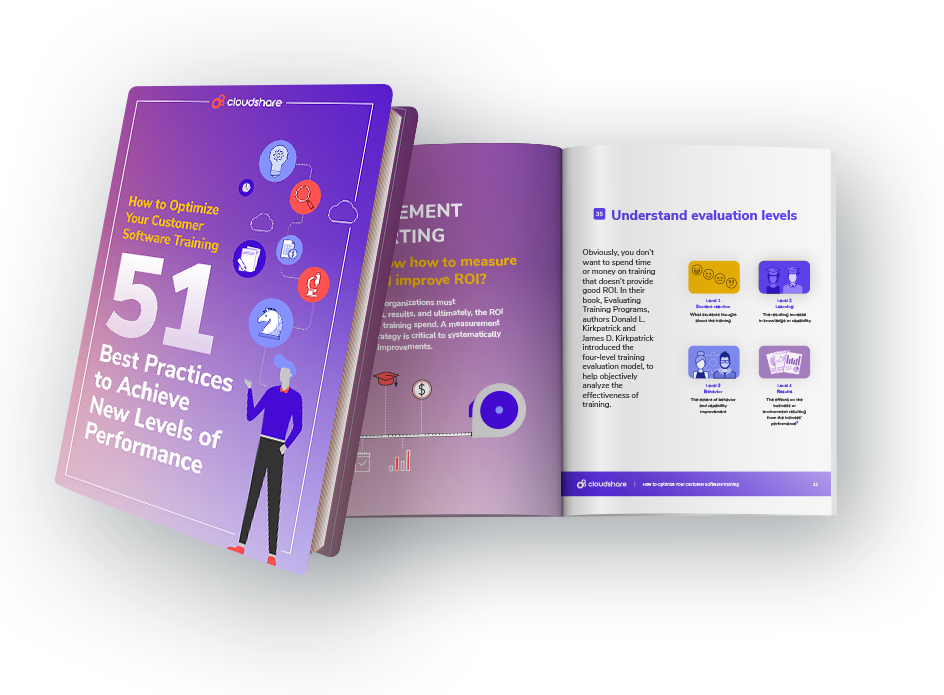
“Training contributes directly to product adoption, customer success, and company growth,” says the first paragraph of our popular ebook, How to Optimize Your Customer Software Training.
If you haven’t yet downloaded the eBook, you’ll want to do so now. It’s packed with 51 best practices to achieve new levels of performance in customer software training.
51 Best Practices to Boost Customer Software Training

When you get into the eBook, you’ll find a list of detailed, actionable tips for each of the eight process capabilities (see below) that define great training organizations, according to Training Industry and its founders Doug Harward and Ken Taylor, authors of What Makes a Great Training Organization.
Though they haven’t changed the list of process capabilities from the book they published in 2014, they revisit each in a research report that followed in 2018. The report examines the factors that differentiate high-performing training functions and offers recommendations your organization can apply to improve performance.
The 8 essential process capabilities are:
- Strategic alignment
- Content development
- Delivery
- Diagnostics
- Reporting and analysis
- Technology integration
- Administrative services
- Portfolio management
The list above is revealed in the order that training professionals rated them as critical. In other words, strategic alignment was deemed most critical, and so forth down the line.
Master the entire list and you’re bound to produce great outcomes for your software training programs. Of course, mastery—for most—is more of an ambition than reality. Only 13% excel at all of them. Interestingly, the numbers have changed very little over the past decade.
Let’s take a look at some of the research findings as they relate to these 8 process capabilities.
Strategic alignment
Strategic alignment placed above all others by a long shot. 78% called it critical yet only 27.5% claimed to be strong in this area.
Great strategic alignment, according to Training Industry, means customizing your training needs to meet the organization’s needs, agreeing on business objectives, and adapting your training to the organization’s unique business or culture.
It’s interesting to note large organizations tend to find it more difficult to identify the clear vision required to achieve strategic alignment. The study points out they have many competing interests to juggle and their size makes communication increasingly difficult.
Content development
The majority of professionals in the study rated content development as critical and 26.6% were willing to claim to be strong.
A trio of must-haves for great content development include:
- Making engaging and interactive content
- Using relevant examples
- Involving subject matter experts
Diagnostics
Diagnostics is the process of identifying performance problems and determining if training can solve it. Doing so is obviously challenging as less than 18% claim it as a strength.
How to you get there? The report claims (1) listening to uncover business problems and needs and (2) identifying competency gaps are the keys.
Delivery
Our ebook asks, “Are your students learning the material?” It explains content delivery encompasses how the training is conveyed, distributed, and accessed. And it also says high-performing training organizations make courses available utilizing a variety of delivery methods.
51 Best Practices to Boost Customer Software Training

Training Industry claims delivery becomes increasingly complex as new training modalities emerge. We’ll dig a bit deeper on this topic by extracting five best practices from our eBook:
Understand your options—Online and off, a spectrum of content delivery modalities is now available to software trainers.
Integrate e-learning methodologies—E-learning might include virtual instructor-led training (VILT), electronic performance support systems, video, mobile learning methods, and more. Blended approaches may integrate live, interactive and offline components.
Work together—Great content delivery requires linking design and development to delivery expectations. The process works effectively when developers and instructors work together.
Profile instructor requirements—To maintain consistent quality, the development team should define the skills and qualities required of program instructors. Learning leaders must then ensure delivery processes are properly executed.
Insist on great facilitation and presentation skills—Instructors must have excellent facilitation and presentation skills. Our eBook presents a great list of 14 qualities to look for, from Harward and Taylor’s book.
Anticipate the need to scale—Top training organizations have the ability to train a small or large numbers of customers. Effective scalability requires effective use of resources and the ability to communicate consistently.
Reporting and analysis
Training organizations cannot assume its training is effective and making a positive impact. Accurate reporting and analysis are required, yet a mere 10% rate their organization strong in the area of reporting and analysis.
Above all, the formula for achieving effective reporting and analysis calls for measuring learning outcomes and collecting course feedback from all relevant parties.
Technology integration
As training organizations move toward using multiple forms of technology to create, deliver and measure training, integrating technology becomes more important.
Unsurprisingly, technology integration is one of only three process capabilities whose importance ratings have increased over time. Learning technologies give training organizations the ability to scale their operations and provide access to learners regardless of location.
However, most industries rate technology integration as their lowest-performing process capability (technology and medical industries are the exception). And here again, only 10% feel they’re strong in this important area.
Three keys to achieving great technology integration involve enabling content to work with multiple learning technologies, such as virtual training labs, using different types of learning technologies, and communicating with the IT staff.
Administration services
When a training organization is strong in the area of administrative services it delivers a seamless experience for both learners and training administrators. 20% claim to do so. When asked to rate the importance of administrative practices, training professionals delivered the top four responses:
- Tracking course completions
- Tracking test results or other outcomes
- Scheduling
- Registration
Portfolio management
Portfolio management ranks eighth in Training Industry’s research but as programs expand, it’s far from insignificant. The practices deemed to be most important include using a variety of methods or tools and the ability to add and/or refresh older material.
The goal is to improve continuously
The most mature training organizations promote continuous improvement and recognize their processes must adapt as business needs change.
High-performing organizations strive for ongoing innovation, and often, seek the services of external partners. Though they may work with external partners on any or all process capability, technology integration is the most common area training organizations get assistance from vendors.
Great training organizations are process-oriented and seek to use a structured approach for addressing their shortfalls. They understand working to improve the eight essential process capabilities is critical to achieving a competitive advantage and realizing important opportunities for growth.


